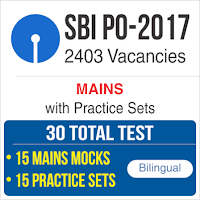SBI PO और NIACL Assistant की परीक्षा के लिए अब केवल कुछ ही दिन शेष हैं. यह समय SBI PO Prelims और NIACL Assistant Prelims 2017 की परीक्षा के लिए अपनी तैयारी में तेजी लाने का है. यह अंग्रेजी के प्रश्न आपको BOB PO और NICL AO 2017 recruitment examination में भी बेहतर अंक प्राप्त करने में सहायता करेंगे. हम व्याकरण अनुभाग के लिए study notes भी प्रदान कर रहे है. और आप New Pattern English Questions का भी अभ्यास कर सकते है.
Directions (1-10): Read the following Passage, and answer the questions based on this passage.
Despite the best efforts of those responsible for preventing fraud, one inevitable reality remains: “fraud happens.” Because fraud and misconduct can occur at various levels in any organization, it is essential that appropriate preventive and detective techniques are in place. Although fraud prevention and detection are related concepts, they are not the same. While prevention encompasses policies, procedures, training, and communication, detection involves activities and programs designed to identify fraud or misconduct that is occurring or has occurred. Although preventive measures cannot ensure that fraud will not be committed, they are the first line of defense in minimizing fraud risk. This section of the guide will cover preventive techniques. Detective techniques will be covered in Section 4.
One key to prevention is making personnel throughout the organization aware of the fraud risk management program, including the types of fraud and misconduct that may occur. This awareness should enforce the notion that all of the techniques established in the program are real and will be enforced. The ongoing communication efforts could provide information on the potential disciplinary, criminal, and civil actions that the organization could take against the individual.With this in mind, prevention and deterrence are interrelated concepts. If effective preventive controls are in place, working, and well-known to potential fraud perpetrators, they serve as strong deterrents to those who might otherwise be tempted to commit fraud. Fear of getting caught is always a strong deterrent. Effective preventive controls are, therefore, strong deterrence controls.
The system of internal controls in an organization is designed to address inherent business risks. The business risks are identified in the enterprise risk assessment protocol, and the controls associated with each risk are noted. COSO’s Enterprise Risk Management–Integrated Framework describes the essential ERM components, principles, and concepts for all organizations, regardless of size.
Establishing internal controls may not address all of an organization’s fraud risks. Fraud risks, although a form of business risk, necessitate specific controls to mitigate them, which makes an organization’s fraud risk assessment process essential to fraud prevention. In addition to implementing fraud preventive controls, it is important that the organization assess and continuously monitor their operational effectiveness to help prevent fraud from occurring.
Prevention is the most proactive fraud-fighting measure. The design and implementation of control activities should be a coordinated effort spearheaded by management with an assembled cast of employees. Collectively, this cross section of the organization should be able to address all of the identified risks, design and implement the control activities, and ensure that the techniques used are adequate to prevent fraud from occurring in accordance with the organization’s risk tolerance. The ongoing success of any fraud prevention program depends on its continuous communication and reinforcement. Stressing the existence of a fraud prevention program through a wide variety of media — posters on bulletin boards, flyers included with invoices and vendor payments, and articles in internal and external communications — gets the message out to both internal and external communities that the organization is committed to preventing and deterring fraud.
Among the many elements in fraud prevention are HR procedures, authority limits, and transaction level procedures. An organization’s HR function can play an important role in fraud prevention by implementing the following procedures. A key business and fraud risk in any organization lies in the people hired to operate the business and promoted into positions of trust and authority. For that reason, it is important to know employees in order to evaluate their credentials and competence, match skills to the job requirements, and be aware of any issues of personal integrity that may impact their suitability for the position. Much can be learned about an individual through confirmation of work history and education presented on a job application or résumé or in follow-up with references provided. It is possible to find false or embellished information or undisclosed history and reputation that may represent increased, and possibly unacceptable, risk.
While the organization should establish procedures to obtain sufficient information to assess a job applicant or promotion candidate, the nature and extent of information that can be requested from a prospective or existing employee or obtained independently is governed by applicable laws and regulations. Further or enhanced background checking for criminal record or personal financial situation may only be possible upon receiving the individual’s consent. Legal counsel should be sought to advise on what background information can and cannot be obtained and the appropriate procedures to follow.
Background checks should also be performed on new and existing suppliers, customers, and business partners to identify any issues of financial health, ownership, reputation, and integrity that may represent an unacceptable risk to the business.
Q1. According to the passage, what is the fundamental difference between fraud prevention and fraud detection?
(a) Background checks should also be performed on new and existing suppliers, customers, and business partners to identify any issues of financial health, ownership, reputation, and integrity that may represent an unacceptable risk to the business.
(b) prevention means to stop something from happening, while detection means to figure out the cause of an action
(c) prevention is not to allow data exchange and detection is to identify the problem
(d) prevention encompasses policies, procedures, training, and communication, detection involves activities and programs designed to identify fraud
(e) None of these
Q2. What will be appropriate title for this passage?
(a) corruption and its repercussions
(b) fraud: analysis and recommendations
(c) fraud: prevention and detection
(d) corruption and hierarchy
(e) None of these
Q3. How the HR department of an organization can play vital role in the prevention of fraud in the company?
(a) by announcing yearly appraisal and spreading the goodwill among the employees
(b) by highlighting the activities that are unfavorable in terms of finance
(c) by evaluating employee’s credentials and competence, and being aware of any issues of personal integrity, confirmation of work history and education presented on a job application
(d) the company can hire a detective to understand the fraud patterns
(e) None of these
Q4. What is the strong deterrent for fraud according to this passage?
(a) the fear of getting caught
(b) the fear of not getting paid
(c) the feeling of being marginalized
(d) the HR policies and its repercussions
(e) None of these
Q5. Apart from the employees, who are the other entities that have been suggested to keep a watch on for fraud purposes?
(a) the lower-class employees and the transport department of the organization
(b) on new and existing suppliers, customers, and business partners to identify any issues of fraud
(c) the foreign members for hawala money and other transactions
(d) high echelon and lower strata of the organization
(e) None of these
Q6. In the following question, find the word that is most similar in the meaning to the word “mitigate”?
(a) benefactor
(b) attenuate
(c) benevolent
(d) vitriolic
(e) vituperate
Q7. In the following question, find the word that is most similar in the meaning to the word “Notion”?
(a) impression
(b) chagrin
(c) chauvinistic
(d) Felonious
(e) charlatan
Q8. In the following question, find the word that is opposite in the meaning to the word “prevention”?
(a) despotic
(b) harbinger
(c) fortuitously
(d) immaculate
(e) permissive
Q9. In the following question, find the word that is opposite in the meaning to the word “embellished”?
(a) accredit
(b) unaccredited
(c) inadmissible
(d) increment
(e) simplify
Q10. In the following question, find the word that is opposite in the meaning to the word “inevitable”?
(a) malapropos
(b) opportunely
(c) sequestrate
(d) uncertain
(e) commandeer













